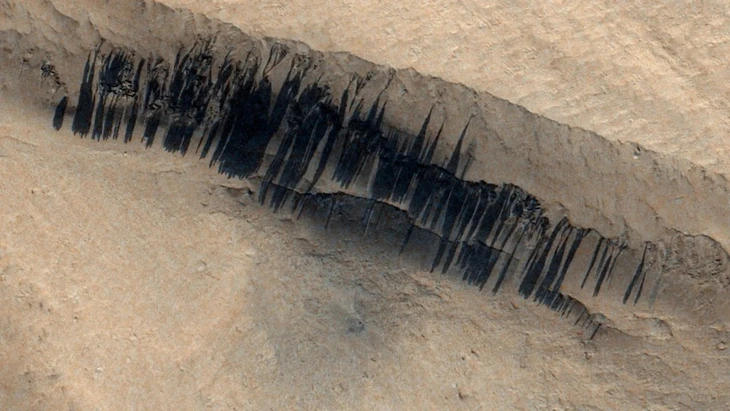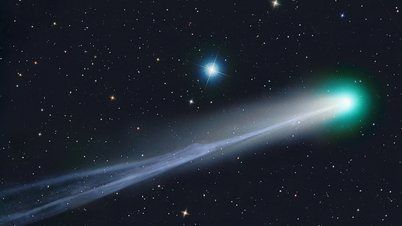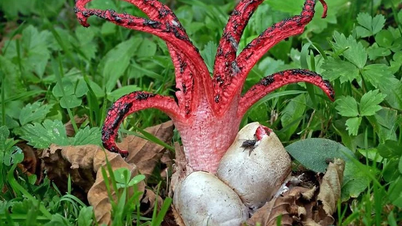
Parallel black streaks run along the mountainside, looking exactly like a giant barcode engraved on Mars - Photo: ESA/TGO/CaSSIS
The strange scene on Mars was recorded in late 2023, but it was not until November 2025 that scientists completed the analysis and published the results in the journal Nature Communications .
Images captured by the European Space Agency’s Trace Gas Orbiter show narrow dark streaks stretching down the slopes of Apollinaris Mons, an extinct volcano near the Martian equator. Each streak marks the remains of a dust avalanche, triggered when a meteorite crashed onto the surface and shook up the fine dust covering the slopes.
Although they cover less than 0.1% of the planet’s surface, these “dust slides” play a major role in Mars’ dust cycle. According to scientists, the amount of dust they release each year is equivalent to at least two global dust storms, contributing significantly to the Red Planet’s climate system.
New research led by Valentin Bickel of the University of Bern (Switzerland) shows that less than one in a thousand of these dust slides originate from meteorite impacts. The majority are due to seasonal variations in winds and natural dust activity.
Bickel and his team analyzed more than 2 million dust slides across 90,000 images taken by Mars orbiters, primarily from NASA’s Mars Reconnaissance Orbiter (MRO). They used deep learning algorithms to scan the data and determine when and where each slide formed, revealing seasonal patterns in the fluctuations of Martian dust.
The results showed that the phenomenon is most prevalent in the southern hemisphere’s summer and fall, when winds are strongest enough to lift tiny dust particles. When the amount of dust these streaks stir up with atmospheric circulation data, the team found that they contribute to moving about a quarter of the total dust exchanged between the surface and the atmosphere each year, about the same amount as two global hurricanes.
The most favorable conditions for the formation of streaks have been identified as dawn and dusk, but no orbiter has yet recorded this process directly due to limited light during those hours.
The study also identified five “hotspots” where the phenomenon is most prevalent, including Amazonis, the area around Olympus Mons, Tharsis, Arabia and Elysium, areas with steep terrain, loose dust and winds strong enough to trigger surface displacement.
These observations help us better understand the processes taking place on Mars today, and provide important clues for future research on the red planet's environment, said Colin Wilson, mission scientist for the Trace Gas Orbiter.
Source: https://tuoitre.vn/sao-hoa-lo-ma-vach-ky-la-sau-tran-lo-bui-do-thien-thach-gay-ra-20251112134901957.htm



![[Photo] Prime Minister Pham Minh Chinh attends a conference to review one year of deploying forces to participate in protecting security and order at the grassroots level.](https://vphoto.vietnam.vn/thumb/1200x675/vietnam/resource/IMAGE/2025/11/12/1762957553775_dsc-2379-jpg.webp)


![[Photo] Highways passing through Dong Nai](https://vphoto.vietnam.vn/thumb/1200x675/vietnam/resource/IMAGE/2025/11/12/1762940149627_ndo_br_1-resize-5756-jpg.webp)


































































































![Dong Nai OCOP transition: [Article 3] Linking tourism with OCOP product consumption](https://vphoto.vietnam.vn/thumb/402x226/vietnam/resource/IMAGE/2025/11/10/1762739199309_1324-2740-7_n-162543_981.jpeg)







Comment (0)